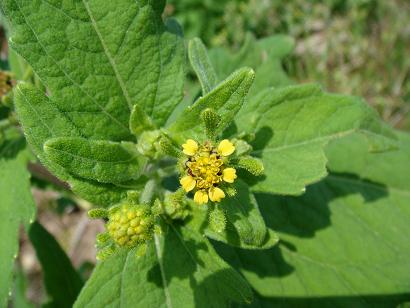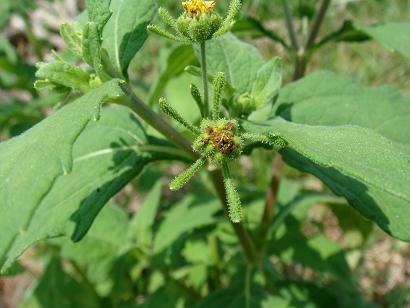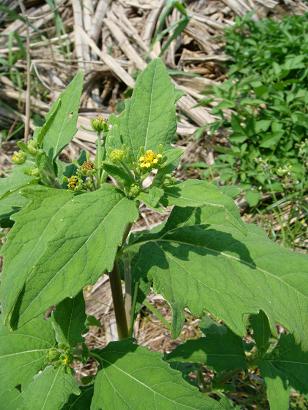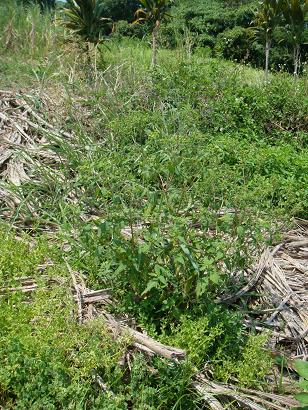 |
 |
 |
|---|---|---|
| July 2008 at Okinawa |
July 2008 at Okinawa |
July 2008 at Okinawa |
| Family | Asteraceae (alt. Compositae) |
| Scientific name | Sigesbeckia orientalis L. |
| Synonyms | Siegesbeckia brachiata Roxburgh; Siegesbeckia gracilis de Candolle; Siegesbeckia microcephala de Candolle; Siegesbeckia orientalis L.; Siegesbeckia orientalis L. forma angustifolia Makino; Siegesbeckia orientalis L. var. angustifolia Makino; Sigesbeckia humilis Koidzumi; Sigesbeckia iberica Willdenow; Sigesbeckia orientalis L. subsp. caspica Kitamura |
| Common name | (Japanese common name) tuskushi-me-namomi (ツクシメナモミ, 筑紫雌ナモミ [meaning: Tsukusi female namomi (Tsukushi = an old name of Fukuoka Prefecture in Kyushu; meaning of namomi is unknown)] |
| (English common name) none | |
| Distribution | (Japan) Honshu (west of Kanto region; mere), Shikoku, Kyushu, Okinawa |
| (Other nations) China, Taiwan, Australia, India, Kenya, Tanzania, Uganda, Madagascar, Bolivia | |
| Habitat | Field, farm yard |
| Chromosomal number | 2n=30 |
| Description | Plants electing ca. 30-80cm tall. Leaves ca. 8-12cm long. Flowers yellow ca. 5-8mm across, flowering in July to September (all seasons in Okinawa). Perennial plants. |
| Reference | Sigesbeckia orientalis L. |
| Sigesbeckia orientalis L. | |
| ent-Pimarane-Type Diterpenoids from Siegesbeckia orientalis L. | |
| Compositions with analgesic, antipyretic and antiinflammatory properties (US Patent 5908628/1999) | |
| Tocopherol esters and their cosmetic and pharmaceutical uses (US Patent 6136851/2000) | |
| Use of potentilla erecta extract in the cosmetic and pharmaceutical field (US Patent 6193975/2001) | |
| Herbal chinese joint complex (US Patent 6350476/2002) | |
| Uses of D-xylose, the esters thereof and oligosaccharides containing xylose for improving the functionality of epidermal cells (US Patent 6495147/2002) | |
| Cosmetic treatment method for fighting against skin ageing effects (US Patent 6471972/2002) | |
| Cosmetic dermabrasion treatment system (US Patent 7179477/2007) | |
| Antiaging cosmetic delivery systems (US Patent 7320797/2008) | |
| Note | Siegesbeckia orientalis L. occurs mainly in Okinawa and southern Kyushu. |
| Digital flora of China has described 'It is virtually impossible to effectively distinguish S. orientalis from S. glabrescens; they are thus treated as synonymous.' |
 |
 |
 |
|---|---|---|
| July 2008 at Okinawa |
July 2008 at Okinawa |
July 2008 at Okinawa |
 |
 |
|---|---|
| July 2008 at Okinawa |
July 2008 at Okinawa |